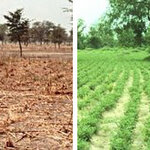Science category landing
Physical Sciences

Scientists at the U.S. Department of Energy's Argonne National Laboratory have identified a new technique for cleansing contaminated water and potentially purifying hydrogen for use in fuel cells, thanks to the discovery of a innovative type of porous material.
Argonne materials scientists Peter Chupas and Mercouri Kanatzidis, along with colleagues at Northwestern and Michigan State universities, created and characterized porous semiconducting aerogels at Argonne's Advanced Photon Source (APS). The researchers then submerged a fraction of a gram of the aerogel in a solution of mercury-…

Plant scientists have known for some time that genes from the maternal plant control seed development, but they have not known quite how.
Scientists at the University of Oxford have paved the way for bigger and better quality maize crops by identifying the genetic processes that determine seed development.
Working in collaboration with researchers in Germany and France, Professor Hugh Dickinson's team found that only the maternal copy of a key gene responsible for delivering nutrients is active. The copy derived from the paternal plant is switched off. This gene encodes a potential…

National Institute of Standards and Technology (NIST) has developed an improved version of a real-time magnetic microscopy system that converts evidence of tampering on magnetic audio and video tapes—erasing, overdubbing and other alterations—into images with four times the resolution previously available.
This system is much faster than conventional manual analysis and offers the additional benefit of reduced risk of contaminating the tapes with magnetic powder. NIST recently delivered these new capabilities to the Federal Bureau of Investigation (FBI) for validation as a forensic tool.…

A NASA researcher has developed a new method to anticipate food shortages brought on by drought. Molly Brown of NASA’s Goddard Space Flight Center in Greenbelt, Md., and her colleagues created a model using data from satellite remote sensing of crop growth and food prices.
Brown conceived the idea while working with organizations in Niger, West Africa, that provide information regarding failed crops and help address local farmers' worries about feeding their families. Brown's new approach could improve the ability for government and humanitarian aid officials to plan and respond to drought-…

Researchers have identified a gene-regulating protein in the brains of mice that triggers the animals' ability to cope with the "behavioral despair" caused by inescapable stress. They said their studies have yielded an animal model of resilience that they will use to explore how antidepressants work on the brain circuitry involved in such stress response.
In earlier studies, Eric Nestler and his colleagues showed that exposure to repeated stress caused an increase in a protein called ∆FosB in the brain. This protein is a "transcription factor," a regulatory protein that controls the activity…

Primetime crime drama meets reality in forensic research taking place at the Midwest Forensics Resource Center at Iowa State University.
Ames Laboratory scientists are using the new Direct Analysis in Real Time mass spectrometry interface, which has made a guest appearance on the popular crime show "CSI: New York," to build a library of ink mass spectra using samples from the US Secret Service. The mass spectra library will help identify inks on fraudulent documents and other crime evidence.
DART mass spectrometry analyzes ink by creating a stream of warm gas containing excited-state helium…

A team of led by Norwich BioScience Institutes Professor Nick Harberd have discovered how plants evolved the ability to adapt to changes in climate and environment.
Plants adapt their growth, including key steps in their life cycle such as germination and flowering, to take advantage of environmental conditions. They can also repress growth when their environment is not favorable. This involves many complex signalling pathways which are integrated by the plant growth hormone gibberellin.
Publishing in the journal Current Biology, the researchers looked at how plants evolved this ability by…

Organic farming can yield up to three times as much food as conventional farming on the same amount of land---according to new findings which refute the long-standing assumption that organic farming methods cannot produce enough food to feed the global population.
Researchers from the University of Michigan found that in developed countries, yields were almost equal on organic and conventional farms. In developing countries, food production could double or triple using organic methods, said Ivette Perfecto, professor at U-M's School of Natural Resources and Environment, and one the study's…

In the first scientific publication from The Genographic Project, a five-year effort to understand the human journey, researchers report their experience of genotyping human mitochondrial DNA during the first 18 months of the project.
Writing in PLoS Genetics, Doron Behar and colleagues describe the procedures used to generate, manage and analyze the genetic data from 78,590 public participants. They also provide the first anthropological insights in this unprecedented effort to map humanity’s genetic journey through the ages.
An ongoing debate in the field of human population genetics…
During flowering four different types of floral organs need to be formed:
Sepals, which protect the inner organs;
The frequently ornamental petals;
Stamens, which produce pollen and;
The carpels, the female reproductive unit.
This process is orchestrated by a large number of genes. Scientists at the Max Planck Institute for Plant Breeding Research in Köln (Germany) found, in cooperation with colleagues in Nijmegen (Netherlands) that a small molecule, a so-called microRNA, is crucial for the control of floral organs identity.
Flowers of higher plants are built in a similar pattern: their…